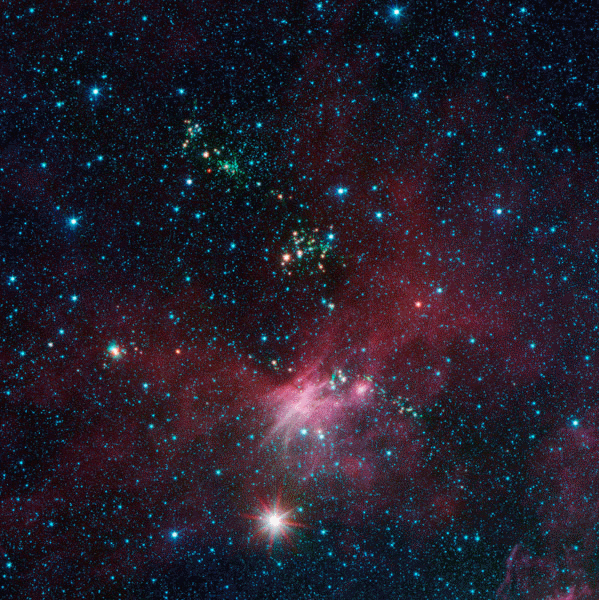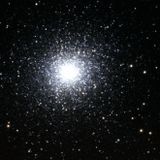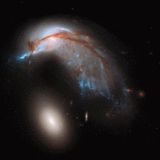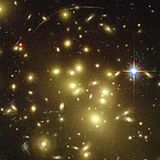
By Tammy Plotner
Thanks to the technology behind NASA's Spitzer Space Telescope, we're able to witness stars blooming in a celestial desert. Far away from the star-crowded core of the Milky Way, the images created by the Galactic Legacy Infrared Mid-Plane Survey Extraordinaire (Glimpse 360) project are providing us with a complete map of our galaxy's topography. This full, 360 degree view of the Milky Way plane will be available later this year, but anyone with a computer can access the Glimpse images and help catalog its many features.
Like a CD, our galaxy is a vast, spiral collection of stars that appears flat. However, there is a slight warp. If you were to take a look at the Milky Way from above, you'd find our solar system about two-thirds of the way out from the center, located in an area known as the Orion Spur, a branch of the Perseus spiral arm.
Through the use of Spitzer's infrared observations, astronomers are now able to refine their mapping capabilities, showing a more precise galactic shape. This includes the warp in an otherwise flat disc. Although other telescopes, including the Spitzer, have looked to the center outward and charted the galactic plane before, these new images are taking a closer look at where the stellar population is the thinnest.
"We sometimes call this flyover country," said Barbara Whitney, an astronomer from the University of Wisconsin at Madison who uses Spitzer to study young stars. "We are finding all sorts of new star formation in the lesser-known areas at the outer edges of the galaxy."

Image: Dozens of newborn stars sprouting jets from their dusty cocoons have been spotted in images from NASA's Spitzer Space Telescope. In this view showing a portion of sky near Canis Major, infrared data from Spitzer are green and blue, while longer-wavelength infrared light from NASA's Wide-field Infrared Survey Explorer (WISE) are red.
According to the news release, Whitney and the research team are using the data to locate areas containing young stars. Their mission has been successful and one of the notable achievements includes cataloging an area near Canis Major where more than 30 stars in their early phases have been observed sprouting jets of material.
But that's not all. Through the use of the Glimpse 360 data, the scientific team has identified 163 additional regions where this activity also occurs. This information shows the youthful stars not only as individual objects, but gathered in clusters as well.
The Spitzer information also has other uses, such as assisting researchers to better calculate stellar distances. Astronomers are taking note of "a distinct and rapid drop-off of red giants, a type of older star at the edge of the galaxy." Warp speed? You bet. This new data aides the mapping of the warp structure in the Milky Way disc.
"With Spitzer, we can see out to the edge of the galaxy better than before," said Robert Benjamin of the University of Wisconsin, who presented the results at the 222nd meeting of the American Astronomical Society in Indianapolis. "We are hoping this will yield some new surprises."
The Spitzer's infrared instruments are playing a crucial role in improving images of the most remote locations in our galaxy and information from NASA's Wide-field Infrared Survey Explorer (WISE) is providing even more details. WISE surveyed the entire sky twice in the infrared spectrum and Spitzer adds the finishing details. By combining their data, we're able to finally take a look at areas we simply don't know much about - the outer regions.
Now, Glimpse 360 has improved things further by mapping 130 degrees of the sky around the galactic center.
Is searching for stars in the most remote corners of our galaxy a solitary job? Not hardly. As exciting as these new results are, what makes it even more fun is the fact that it has had a lot of help from citizen scientists - astronomers like you and me.
Right now, members of the public are continuing to sift through earlier Glimpse data releases. They are participating in The Milky Way Project and searching for cosmic "bubbles," the possible sites of hot, massive stars. The results include the identification of an impressive bubble structure in a star-forming region named W39. When identified by the volunteers, the researchers took a closer look and found the smaller bubbles were the product of massive stars excavating their way through an even larger bubble.
"This crowd-sourcing approach really works," said Charles Kerton of Iowa State University at Ames, who also presented results. "We are examining more of the hierarchical bubbles identified by the volunteers to understand the prevalence of triggered star formation in our galaxy."
For more information about the Milky Way project and to learn how to participate, visit: http://www.milkywayproject.org
Original Story Source: JPL/NASA News Release
Tammy Plotner is a professional astronomy author, President Emeritus of Warren Rupp Observatory and retired Astronomical League Executive Secretary. She's received a vast number of astronomy achievement and observing awards, including the Great Lakes Astronomy Achievement Award, RG Wright Service Award and the first woman astronomer to achieve Comet Hunter's Gold Status.



















